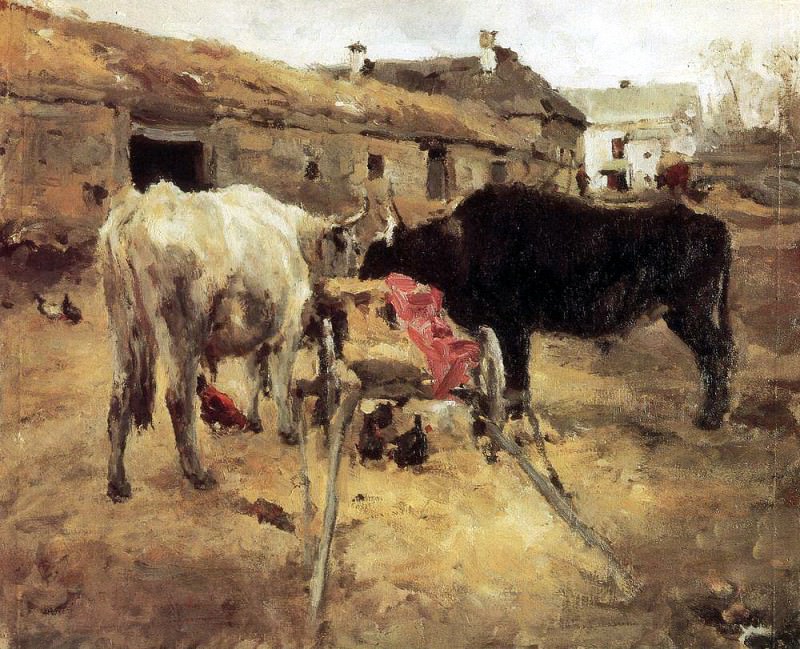Oxen. 1885 Valentin Serov (1865-1911)
Valentin Serov – Oxen. 1885
Edit attribution
Download full size: 1000×811 px (0,2 Mb)
Painter: Valentin Serov
1885; canvas, oil; 47,5×59,5; Tretyakov Gallery. This picture belongs to the early period of the artist’s work, but it already displays characteristic features of Serov’s style: confident control of brush and clear rough brush strokes. The subject from rural life, chosen for the sketch, is remarkable for its vivid originality. At first glance, he masterfully depicts a simple scene of feeding the oxen after a working day.
Description of Valentin Serov’s painting "Vols".
1885; canvas, oil; 47,5×59,5; Tretyakov Gallery.
This picture belongs to the early period of the artist’s work, but it already displays characteristic features of Serov’s style: confident control of brush and clear rough brush strokes.
The subject from rural life, chosen for the sketch, is remarkable for its vivid originality. At first glance, he masterfully depicts a simple scene of feeding the oxen after a working day. The color contrast of black and white adds depth to the painting and leads the viewer to reflections on the dual nature of the world.
It seems as if a pair of animals is deliberately chosen, coming together at the wagon filled with hay. A scarlet rag thrown carelessly over the straw adds color, as if dividing the picture in two. Another bright spot of color is a hen between the hooves of white oxen. Against the overall neutral background, these details create an unsettling feeling, making the scene emotionally intense, lively, and eye-catching.
Elaboration of the background is done thoroughly, but it doesn’t distract from the main characters of the painting. Slouching farm buildings, white house in the distance, gray overcast sky, trampled ground of cattle yard under the feet of animals - all these together create a melancholic mood. The eye against its will focuses on the center of the painting, where the oxen, almost touching their muzzles, are busy feeding.
The work, done by the master’s steady hand, looks three-dimensional, full of life and meaning. Its proportions are amazingly harmonious, and the viewer’s eye moves smoothly from one detail to another, perceiving the story as a whole. The painter’s sketch of village life transforms into the eternal motif of the unity of two opposites.
Кому понравилось
Пожалуйста, подождите
На эту операцию может потребоваться несколько секунд.
Информация появится в новом окне,
если открытие новых окон не запрещено в настройках вашего браузера.
You need to login
Для работы с коллекциями – пожалуйста, войдите в аккаунт (open in new window).




















You cannot comment Why?
The oxen are tethered to a wooden cart or plow, which is positioned between them. A splash of vibrant red fabric drapes over the structure, providing a striking contrast against the muted earth tones that characterize much of the scene. Scattered around the base of the cart are small chickens, adding a touch of domesticity and further reinforcing the pastoral setting.
Behind the animals, a modest farmhouse is visible. Its construction appears rudimentary, with a thatched roof and walls built from roughly hewn stone. A few figures can be discerned near the building, though their activities remain ambiguous due to the distance and atmospheric perspective. The landscape beyond the farm recedes into a hazy distance, suggesting an expansive rural environment.
The artist’s use of light is significant. It appears diffused and warm, bathing the scene in a soft glow that minimizes harsh shadows. This contributes to a sense of tranquility and timelessness. The brushwork throughout is characterized by its looseness and immediacy; details are suggested rather than meticulously rendered, which lends a feeling of spontaneity to the work.
Subtly, the painting conveys themes of rural toil and the cyclical nature of agricultural life. The oxen, symbols of strength and endurance, represent the essential labor that sustains human existence in this setting. The dilapidated farmhouse and simple cart suggest a modest standard of living, while the chickens evoke notions of family and sustenance. There is an underlying sense of quiet dignity associated with these everyday activities, presented without sentimentality or overt commentary. The muted palette and hazy atmosphere contribute to a feeling of nostalgia, hinting at a connection to a disappearing way of life.